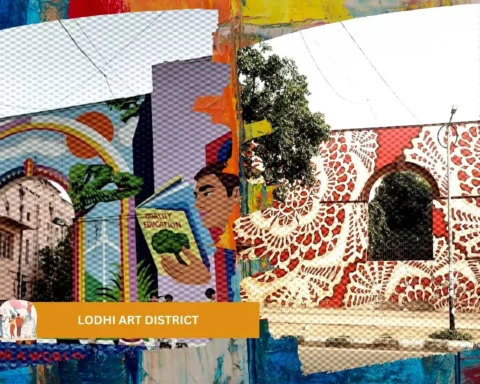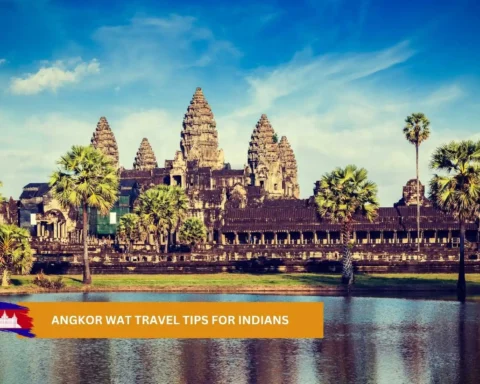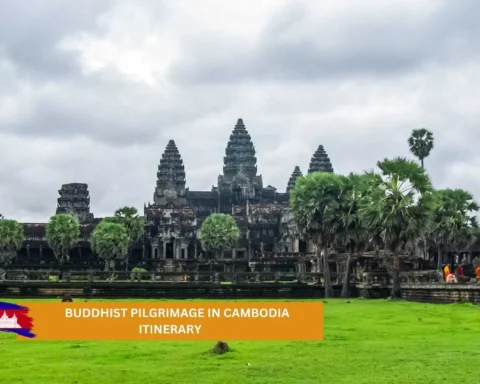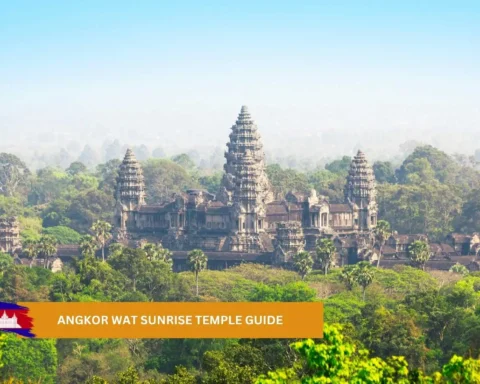The architectural legacy of Cambodia’s ancient temples reflects a powerful blend of cultures spanning across Southeast Asia. From Banteay Srei’s ornate carvings to Angkor Wat’s central towers, Khmer temple architecture shows deep Indian influence while maintaining local identity. Indian temple architecture, especially Dravidian and Indian rock-cut architecture, offered symbolic and structural models that Khmer builders adapted creatively. Rather than directly copying Indian forms, they localized them, giving rise to a distinct and enduring style across the Khmer Empire.
The Indian influence on Khmer architecture is visible in cosmological impressions, sculptural traditions, and sacred symbolism. In this article, we will explore this Indian influence through three key themes: religious and symbolic foundations, architectural adaptation, and the mythological narratives carved into Khmer temples.
Table of Contents
Indian Influence on Khmer architecture: Indian Cosmology in Khmer Temple Design
As Indian cosmology and core spiritual principles began to become a part of the fabric of the Khmer empire, it also became a part of the architecture that defined the religious aspect of the empire. Early Khmer temples such as Preah Ko and Bakong illustrate how Indian spiritual principles were used to assert political authority. Khmer kings embraced the concept of Devaraja worship, or divine kingship, rooted in Indian cosmology. This notion established the monarch as a living god, typically identified with Shiva, and justified temple construction as both religious offering and political legitimization.
The influence of Indian religious cosmology can be seen in the layout of many Khmer temples, especially Angkor Wat. The concentric moats and walls surrounding the central sanctuary symbolize the cosmic oceans and mountain ranges encircling Mount Meru, the sacred axis of the universe in Hindu and Buddhist cosmology. The use of Mount Meru as an organizing principle shows a direct link between Indian philosophy and Khmer temple planning. Khmer temple architecture thus served both as a microcosm of the universe and a symbolic center of royal power.
Indian temple architecture and its guiding texts, such as Vastu Shastra, offered Khmer builders a structural and metaphysical framework. This included principles of symmetry, orientation, and spatial hierarchy. These ideas were incorporated into Khmer temples to create structures that were not only technically advanced but also symbolically charged. The Indian influence on Khmer architecture at this stage was less about replication and more about ideological alignment.

Shikhara to Prasath and the Transformation of Khmer Temple Architecture
As the Khmer Empire grew, so did the scale and complexity of its temples. The transformation from early brick temples to massive sandstone monuments reflects both technical innovation and evolving artistic vision. Many architectural features in Khmer temples show clear links to Indian precedents. The prasat, or temple tower, for example, evolved from the Indian shikhara but was reinterpreted in both form and proportion.
Khmer architecture moved away from the curvilinear spires typical of Indian temples and instead developed stepped pyramids with lotus-bud towers. This evolution is visible in the structure of Ta Keo, one of the first temples built entirely of sandstone. Ta Keo marks a turning point in Khmer temple architecture, where structural techniques borrowed from Indian rock-cut temples like corbelled arches were applied at a monumental scale.
Indian rock-cut architecture also contributed to Khmer methods of carving and assembly, though Khmer temples were freestanding rather than excavated. The decorative elements, such as lintels, pediments, and colonnettes, often employed motifs that originated in Indian sculpture but were adapted to local artistic conventions. Gopuras, or monumental gateways introduced from Indian design, became signature features in Khmer temple architecture, often aligned along sacred cardinal axes.
Another aspect of Indian style was the adaptation of Dravidian temple architecture in temples such as the Brihadeshwara temple. The prevalence of the lesser mainstream South Indian style in Cambodia forms an important part of Southeast Asian architectural history.
Indian Epics in Cambodian Stone
The third major channel of Indian influence is the narrative tradition embedded in temple sculpture. The walls of Khmer temples are covered with elaborate bas-reliefs that depict episodes from the Mahabharata and Ramayana, two of India’s foundational epics. These stories were adapted into the Khmer language and cultural context through the Reamker, a localized version of the Ramayana.
Angkor Wat temple features some of the most extensive and sophisticated narrative reliefs in Khmer architecture. Panels illustrating the churning of the ocean of milk, battles from the Mahabharata, and scenes from Vishnu’s avatars offer insight into how Indian mythological content was reimagined for a Cambodian audience. These reliefs were not merely decorative; they served religious, educational, and political purposes, reinforcing royal ideology and spiritual devotion.
Banteay Srei, a smaller temple north of Angkor, is renowned for its detailed stone carvings. Its panels display episodes from Hindu mythology with a level of intricacy that rivals Indian stone sculpture. Here, the techniques of Indian architecture were not just borrowed; they were elevated to new artistic heights.
Even earlier sites like Preah Ko incorporate Indian deities and mythological themes into their design. The presence of Hindu trinity sculptures, Brahma, Vishnu, and Shiva and narrative friezes underscores the thematic continuity between Indian and Khmer religious expression. These visual elements further exemplify the Indian influence on Khmer architecture, not only in structural layout but in cultural storytelling.
Conclusion
The temples of Cambodia stand as monumental records of cultural convergence. From the grand towers of Angkor Wat and the Bayon temple to the intricately carved pediments of Banteay Srei and the pyramid-like massing of Ta Keo, Khmer architecture embodies a deep and ongoing dialogue with Indian architectural traditions. The Indian influence on Khmer architecture was foundational, not only shaping how temples looked, but also how they functioned, what they symbolized, and the stories they told.
By integrating the symbolic geography of Mount Meru, adopting and transforming elements of Indian temple architecture, and bringing epic Indian narratives into visual form, Khmer builders crafted a style that was simultaneously foreign and deeply native. Their temples were spaces of worship, power, and cosmic alignment, each one an expression of how imported ideas could be moulded to suit local ideals.
The Khmer Empire succeeded not by imitating Indian forms but by transforming them. This creative synthesis led to one of the most distinctive and enduring architectural traditions in Southeast Asia, a legacy that continues to draw scholars, artists, and travelers alike. The Indian influence on Khmer architecture, while undeniable, was never static; it was dynamic, adaptive, and deeply woven into the cultural fabric of ancient Cambodia.

FAQs
How was the Khmer Empire influenced by Indian art?
The Khmer Empire was significantly influenced by Indian culture through the adoption and adaptation of Hinduism and Buddhism, the use of Sanskrit, and Indian architectural styles, particularly in the construction of temples like Angkor Wat.
What is the origin of Khmer Architecture?
Evolved from Indian influences, Khmer architecture became clearly distinct from that of the Indian sub-continent as it developed its own special characteristics, some of which were created independently and others of which were incorporated from neighboring cultural traditions, resulting in a new Khmer art style.
Is Cambodian culture similar to Indian Culture?
Cambodian society which is now predominantly Buddhist retains a strong influence of Indian Hindu and Buddhist rituals, idolatry and mythology which can be seen in many of its rituals having resemblance with Indian culture and traditions.









